The Hand Taiyin System
1. Running Course of the Hand Taiyin System
(1) Channel
The hand taiyin lung channel originates in the middle jiao in the gastric and abdominal region. The channel descends to connect with the large intestine and returns upward to pass the gastric cardia. It crosses the diaphragm and enters its pertaining zang organ, the lung. It exits transversely from the throat region to reach the lower area of the axilla and descends along the medial aspect of the upper arm anterior to the hand shaoyin heart and hand jueyin pericardium channels. It reaches the elbow and descends along the anteromedial aspect of the forearm to enter the cun kou, where the radial pulse beats at the inferior border of the styloid process of the radius. It travels to the thenar eminence, moves along the border where the skin changes color, and terminates at the distal end of the thumb. A branch exits at the styloid process and moves along the radial side of the index finger to its distal end to connect with the hand yangming large intestine channel (Pic. 1-5).
(2) Divergent collateral
The hand taiyin divergent collateral separates at LU 7 (liè quē) above the wrist, travels with its primary channel into the palm, and disperses around the edges of the thenar eminence (Pic. 1-6).
(3) Channel divergence
The hand taiyin channel divergence separates from the primary channel and enters the axilla. It travels anterior to the hand shaoyin heart channel, enters its pertaining zang organ, the lung, and disperses in its fu organ, the large intestine. It ascends towards the supraclavicular fossa and emerges at the body surface. It then travels along the throat and joins the hand yangming large intestine channel. There are six pairs of confluences; this is the sixth exterior-interior confluence (Pic. 1-7).
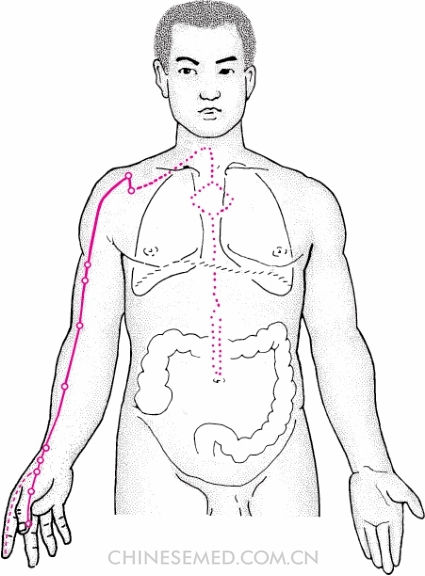

4 Channel sinew
The hand taiyin channel sinew originates at the distal end of the thumb. It ascends along the thumb to bind at the thenar eminence, travels to the lateral aspect of the radial pulse at the cunkou, and moves along the forearm to bind at the elbow joint. It proceeds along the medial aspect of the humerus to below the axilla, exits at the supraclavicular fossa, binds anterior to the acromion, ascends to bind at the supraclavicular fossa, and descends into the chest. It disperses at the diaphragm and associates with the gastric cardia. It gathers at the lower end of the gastroesophageal junction and reaches the region of the floating ribs (Pic. 1-8).
Channel course summary
- The hand taiyin channel runs from the chest to the hand.
- It pertains to the lung, connects with the large intestine, passes the gastric cardia, and associates with the lung system (trachea and throat).
- It travels anterior to the shoulder on the anteromedial aspect of the upper limb and along the superior border of the thenar eminence.
- The channel divergence travels along the throat. The channel sinew binds anterior to the acromion and disperses at the gastric cardia and diaphragm.
- It connects with the hand yangming large intestine channel at the radial side of the index finger.
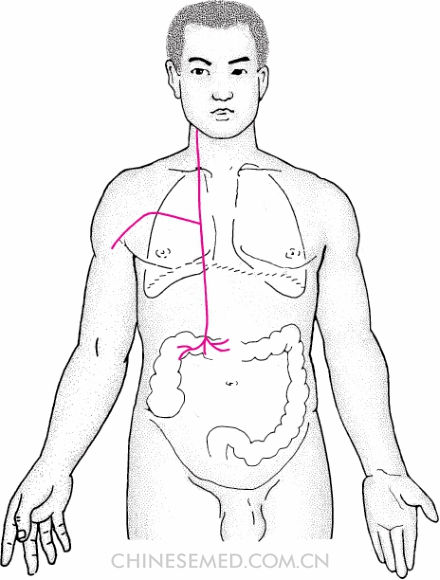

2. Disorders of the Hand Taiyin System
(1) Channel disorders
Channel qi disorders include lung distention, asthma, wheezing, coughing, and pain at the supraclavicular fossa. In severe cases, the arms cross anterior to the chest, and there is blurred vision and delirium; this is known as reversing and blockage of the channel qi of the arm (bì jué,臂厥).
The lung channel is used to treat coughing, hiccups, wheezing, irritation, chest tightness and pressure, pain and coldness at the anteromedial aspect of the upper arm and forearm, and heat in the palms.
When pathogenic qi is abundant, there is a surplus of channel qi, giving rise to an excess pattern. The manifestations of wind invasion are shoulder and back pain, aversion to cold and wind, perspiration, and frequent urge to urinate with scanty output. Insufficient channel qi results in a deficiency pattern. Symptoms include shoulder and back pain, aversion to cold, shortness of breath, and abnormally colored urine.
(2) Divergent collateral disorders
Excess disorders in the divergent collateral present as heat around the styloid process and in the palms. The deficiency pattern presents as yawning and enuresis or frequent urination. Treat using LU 7 (liè quē); the divergent collateral separates here to associate with the hand yangming large intestine channel.
(3) Channel sinew disorders
Disorders of the hand taiyin channel sinew present as pulling pain or cramping along the running course and binding regions of the channel. If severe, channel sinew disorders result in lung qi stagnation, causing xī bēn1 disease, a yin mass in the lungs, and sometimes hematemesis and spasms in the hypochondrium.
Summary of lung system disorders
- Disorders of the lung: Coughing, asthma, shortness of breath, hematemesis, tightness and pain in the chest.
- Externally contracted diseases: Exterior pattern due to wind cold or wind heat.
- Disorders of the throat: Swelling of the throat and hoarse voice.
- Disorders of the lung channel: Pain at the supraclavicular fossa and anterior aspect of the shoulder, pain and chills at the anteromedial aspect of the upper limbs, paralysis of the upper limbs, swelling of the hand and wrist, heat in the palms. Other disorders, including dermatological diseases, burns, frostbite, and sprains, also occur along the external course of the hand taiyin lung channel. All channel disorders may be treated using points along the course of the pertinent channel.
- Abnormal urination: Frequent but scanty urination; retention of urine or enuresis.
- Disorders of the nose: Nasal congestion, epistaxis, sinusitis.
- Acute vomiting and diarrhea.
The Hand Yangming System
1. Running Course of the Hand Yangming System
(1) Channel
The hand yangming large intestine channel begins at the radial side of the tip of the index finger, runs along the superior border of the radial side of the index finger, goes between the first and second metacarpals at LI 4 (hé gŭ), and enters the depression between the extensor pollicis longus and brevis tendons. It continues along the anterior aspect of the forearm to the elbow. It proceeds along the anterolateral aspect of the upper arm to the shoulder and along the acromion, ascending to join all the yang channels at DU 14 (dà zhuī). It enters the supraclavicular fossa to connect with the lung and descends to the diaphragm to associate with its pertaining fu organ, the large intestine. A branch travels from the supraclavicular fossa along the neck, passes through the cheek, and enters the lower teeth. It curves around the upper lip. The right and left channels cross at the philtrum, the right channel continuing on the left and vice versa, to ascend along the sides of the nose and connect with the foot yangming stomach channel (Pic. 1-9).
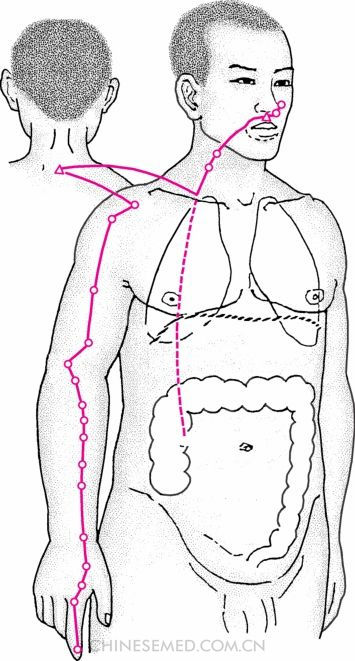
1 息贲. This is one of the five types of yin lumps described in The Classic of difficult Issues (Nàn Jīng, 难经), one for each of the zang organs.
(2) Divergent collateral
The hand yangming divergent collateral separates from the primary channel at LI 6 (piān lì) three cun above the wrist, and branches into the hand taiyin lung channel. A branch ascends to the acromion, passes the neck, and divides at the cheek. One branch associates with the roots of the teeth; another enters the ear (Pic. 1-10).
(3) Channel divergence
The hand yangming channel divergence ascends along the hand to the chest. A separate portion of the channel exits at the acromion, enters the vertebrae at the nape, descends to its pertaining fu organ, the large intestine, and ascends to associate with the lung. It exits at the supraclavicular fossa to reunite with the hand yangming large intestine channel (Pic. 1-11).

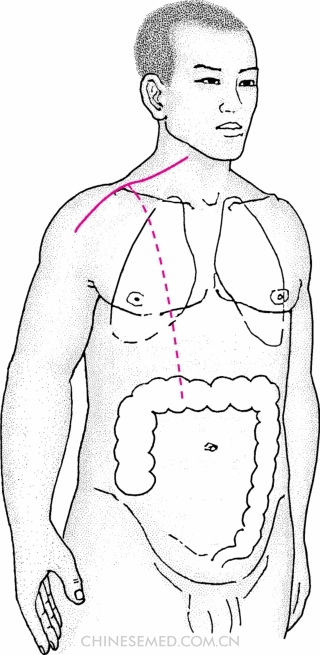
(4) Channel sinew
The hand yangming channel sinew begins at the extremity of the index finger, binds at the wrist, and ascends laterally to bind at the elbow. It then ascends the upper arm to bind to the acromion. A branch separates at the shoulder, winds around the scapula, and travels down both sides of the spine. The main portion of the channel sinew ascends from the shoulder to the neck, where a branch ascends to the cheek and binds at the zygomatic region. The main branch continues to ascend, exits anterior to the hand taiyang channel sinew, and ascends to the left corner of the forehead. It crosses over the head and descends to the opposite mandible (Pic. 1-12).
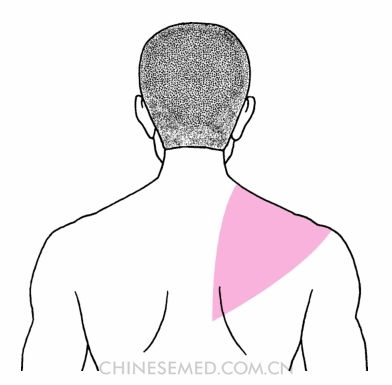
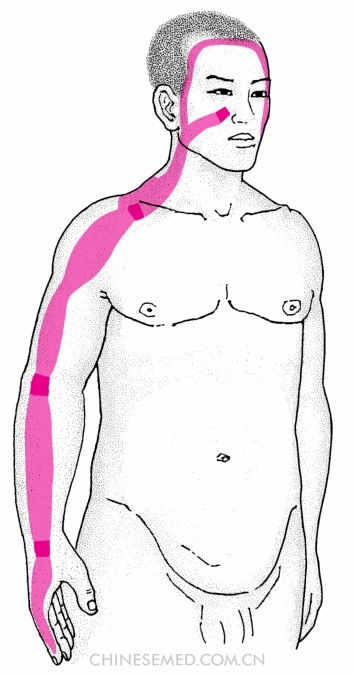
Channel course summary
- The external portion of the hand yangming channel forms the main course; it runs along the superior border of the lateral aspect of the upper limb and passes the nape of the neck at DU 14 (dàzhuī ).
- Distribution on the face is complicated, mainly distributed around the mouth and nose; the right and left channels cross at the philtrum.
- The channel has a close association with the teeth; it ‘enters the lower teeth’.
- The channel pertains to the large intestine and connects with the lung. The divergent collateral ‘enters the ear’. The channel divergence ascends along the throat.
- The channel sinew, with a thicker and wider distribution than the primary channel, ascends to the head where the left and right channels cross and ‘reaches the left corner of the forehead, associates with the head, and descends to the opposite mandible’.
- It connects with the foot yangming stomach channel beside the wings of the nose.
2. Disorders of the Hand Yangming System
(1) Channel disorders
Disorderly channel qi results in symptoms such as toothache and swelling of the neck.
The large intestine channel is used to treat fluid disorders, including yellowing of the sclera, dry mouth, nasal congestion with runny nose or nosebleed, swelling and throat pain and obstruction, as well as pain at the anterior aspect of the shoulder and the lateral aspect of the upper arm, and pain and immobility of the index finger.
Excessive channel qi results in an excess pattern that manifests as heat and swelling along the course of the channel. Channel qi deficiency produces a deficiency pattern with aversion to cold, shivering, and difficulty in regaining warmth.
(2) Divergent collateral disorders
In divergent collateral disorders, the excess pattern presents as tooth decay or deafiness; the deficiency pattern, as cold sensitivity in the teeth or blockage and inhibition around the diaphragm. To treat, use the luo-connecting point, LI 6 (piān lì).
(3) Channel sinew disorders
Disorders of the hand yangming channel sinew manifest as pulling pain with cramping along the running course and the binding regions of the channel, and sometimes-inability to raise the shoulder or rotate the neck.
Summary of large intestine system disorders
- Disorders of the teeth: Toothache, tooth decay, cold sensitivity or hypersensitivity in the teeth.
- Disorders of the face and mouth: Facial paralysis, facial pain, and facial muscle spasms.
- Disorders of the nose and throat: Sinusitis, nosebleed, nasal congestion, pharyngitis.
- Disorders of the upper limb, shoulder, neck, and nape: Paralysis and flaccidity of the upper limb, tennis elbow, inability to raise the shoulder, swelling of neck (swollen thyroid gland, goiter, lymph node inflammation), stiff neck.
- Externally contracted diseases: Exterior patterns due to wind cold and wind heat.
- Disorders of the ear: Deafiness, tinnitus, otitis media.
- Disorders of the large intestine: Abdominal pain, diarrhea, constipation.
The Foot Yangming System
1. Running Course of the Foot Yangming System
(1) Channel
The foot yangming stomach channel begins at the ala nasi and ascends to the bridge of the nose. It intersects with the foot taiyang bladder channel at the medial canthus at BL 1 (jīng míng), descends along the lateral side of the nose, and enters the upper gums. It circles the lips, descends, and meets the ren mai at RN 24 (chéng jiāng). It then travels to the inferior border of the mandible and exits at ST 5 (dà yíng). From ST 6 (jiá chē), it ascends anterior to the ear, passes GB 3 (shàng guān), and follows the hairline to reach the forehead. A branch separates anterior to ST 5 (dà yíng) and descends to ST 9 (rén yíng). It passes along the throat into the supraclavicular fossa, and descends to the diaphragm to enter its pertaining fu organ, the stomach, and connect with the spleen, with which it shares an interior-exterior relationship. The main course runs from the supraclavicular fossa to the medial side of the breast, then lateral to the umbilicus to flank the pubic hair. Another branch starts from the gastric cardia and descends to the inguinal region, where it merges with the external portion of the channel. From there the channel travels to the anterior aspect of the thigh to ST 32 (fútù) and enters the patella. From the patella, it descends along the anterolateral aspect of the tibia to the dorsum of the foot, reaching the lateral side of the tip of the second toe. The tibial branch of the channel separates three cun below the knee, descends, and terminates at the lateral aspect of the third toe. Another branch separates obliquely at the dorsum of the foot to enter the medial aspect of the big toe; it exits at the distal end, where it connects with the foot taiyin spleen channel (Pic. 1-13).
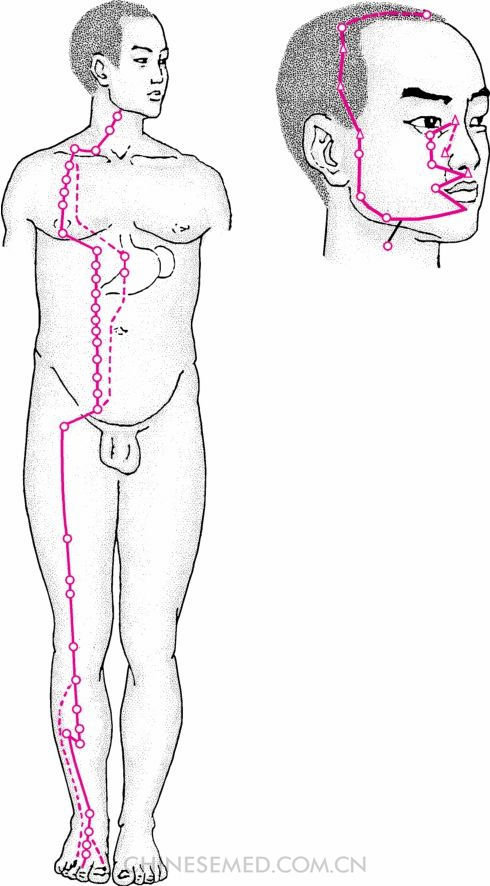
(2) Divergent collateral
The foot yangming divergent collateral separates at ST 40 (fēng lóng) eight cun above the lateral malleolus and connects to the foot taiyin spleen channel. A fork of the vessel ascends laterally along the tibia. It connects with the vertex, where its qi converges with that of the other channels, and descends again to circle the throat region (Pic. 1-14).
(3) Channel divergence
The foot yangming channel divergence exits the primary channel at the thigh and ascends toward the hip joint. The internal portion enters the abdomen, connects with its pertaining fu organ, the stomach, and disperses in the spleen. It ascends to associate with the heart and moves alongside the esophagus to exit at the mouth. It rises to the bridge of the nose and the inferior border of the orbit to connect with the eye before joining the primary channel (Pic. 1-15).
(4) Channel sinew
The foot yangming channel sinew begins at the three middle toes, binds at the dorsum of the foot, ascends obliquely to the fibula, and binds at the lateral aspect of the knee. It continues upward, binds at the hip joint, and moves along the hypochondrium to connect with the spine. The main branch separates at the dorsum of the foot and ascends along the tibia to bind at the knee; a fork connects with the fibula and the foot shaoyang channel sinew. The main branch ascends at ST 32 (fú tù), binds in the pelvic region and converges at the genitals, rises to disperse in the abdomen, and binds at the supraclavicular fossa. It moves up the neck toward the side of the mouth and the zygomatic region to bind below the nose. From the side of the nose, it ascends to form a supporting net around the lower eyelid and connects with the foot taiyang channel sinew, which forms a similar net around the upper lid. A branch separates at the zygomatic region, crosses the cheek, and binds anterior to the ear (Pic. 1-16).
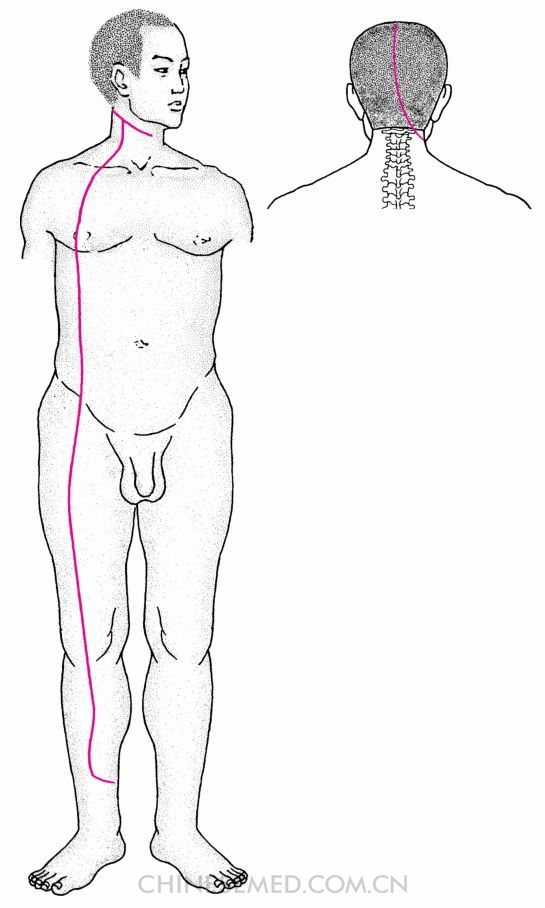

Channel course summary
- The external channel has a long distribution, traveling from head to toe on the anterior of the body.
- It has a complicated distribution on the face, connecting with the mouth, lips, upper teeth, and nose; the channel divergence also connects with the eye.
- It has a close association with the digestive system. It pertains to the stomach, connects with the spleen, and passes the large and small intestines.
- The divergent collateral connects with the throat, and the channel divergence disperses within the heart.
- The channel connects with the foot taiyin spleen channel medially on the big toe.

2. Disorders of the Foot Yangming System
(1) Channel disorders
Disorderly channel qi causes shivering with sporadic tremors, intermittent groaning and stretching of the lower back, and frequent yawning; the forehead also darkens. During onset of this condition, the mind becomes unsettled and averse to fire, to light, and to seeing other people; the patient prefers to close the doors and windows, remains indoors alone, and becomes frantic upon hearing banging sounds made by wooden instruments. If yang is excessive, the patient will climb heights to shout and sing or remove his clothes and dash about and can have abdominal distention, bowel sounds, and a cold sensation in the anterior tibial region that is known as gān jué (骭厥).
The stomach channel is used to treat disorders of blood such as mania, malaria, chronic febrile diseases due to pathogenic heat, spontaneous perspiration, nasal congestion with runny nose or nosebleed, deviated mouth, lip ulcers, swelling of the neck, throat obstruction, abdominal edema, knee swelling and pain, pain along the sides of the chest and breast, pain around fú tù,1 lateral pain at the tibia and the dorsum of the foot, and inability to bend and stretch the middle toes.
Excessive channel qi results in an excess pattern, the manifestations of which are heat sensations in the chest, abdomen, and the anterior of the body. Intense stomach heat produces rapid metabolism of food and water, extreme hunger, and yellow urine. Deficient channel qi causes a deficiency pattern, the symptoms of which are cold and shivering in chest and abdomen. Stomach cold can produce distention and fullness.
(2) Divergent collateral disorders
Divergent collateral disorders manifest as ascending counterflow of qi that causes pharyngitis and sudden loss of voice. The excess pattern presents as bipolar disorder. The deficiency pattern presents as atony of the feet and atrophy of the tibial muscles. Treat divergent collateral disorders with the luo-connecting point, ST 40 (fēng lóng).
(3) Channel sinew disorders
Disorders in the foot yangming channel sinew can cause cramping of the middle toes and tibia, an uncomfortable twitching in the foot, spasms in the region of thigh muscles, swelling in the anterior inguinal region, hernia, abdominal spasms that extend to the supraclavicular fossa and cheek, sudden deviation of the mouth, spasms of the eyelids that prevent the eyes from closing, and if there is heat-lax muscles that prevent the eye from opening. Pathogenic cold causes twitching at the corner of the mouth; heat makes the muscles flaccid, causing deviation of the mouth.
Summary of stomach system disorders
- Foot yangming channel disorders affect the body from head to foot.
- Disorders of the stomach and intestines: Stomachache, stomach distention, vomiting, hiccups, rapid metabolism causing extreme hunger, poor appetite and indigestion, abdominal pain, diarrhea, constipation, dysentery.
- Disorders of the mouth, lips, nose and teeth: Aphtha, bad breath, lip rashes, swelling of the lips, nosebleed, nasal obstruction, sinusitis, toothache (especially in the upper teeth), red and swollen or bleeding gums.
- Facial disorders: Paralysis, pain, muscle spasms.
- Channel disorders: Headache, swelling of the neck, acute mastitis, lumps in the breast, distention and pain in the breasts, insufficient lactation, flaccidity and pain in the lower limbs, patella pain.
- Mental disorders: Mania, depression, epilepsy, insomnia.
The Foot Taiyin System
1. Running Course of the Foot Taiyin System
(1) Channel
1 Fú tù here refers to the anterior region of the thigh.
The foot taiyin spleen channel originates at the tip of the big toe and travels medially on the foot following the border where the skin changes color. It ascends anterior to the medial malleolus and enters the medial aspect of the calf. It runs along the posterior border of the tibia. Eight cun above the medial malleolus, it crosses the foot jueyin liver channel, emerges anterior to it, and continues to ascend, passing the anteromedial aspect of the knee and thigh. It enters the abdomen and its pertaining zang organ, the spleen, and it connects with the stomach, with which it shares an exteriorinterior relationship. It ascends through the diaphragm and runs along the esophagus. It arrives at the root of the tongue and disperses over its lower surface. The abdominal branch of the channel separates from the stomach, ascends through the diaphragm, and enters the heart to connect with the hand shaoyin heart channel (Pic. 1-17).
(2) Divergent collateral
A. The foot taiyin divergent collateral separates at SP 4 (gōng sūn) one cun behind the metatarsophalangeal joint of the big toe. It branches into the foot yangming stomach channel. The ascending branch enters the abdomen and connects with the intestines and stomach (Pic. 1-18a).
B. The major collateral of the spleen separates at SP 21 (dà bāo) three cun below GB 22 (yuānyè), and disperses at the chest and hypochondrium (Pic. 1-18b).



(3) Channel divergence
The foot taiyin channel divergence separates from the primary channel at the thigh, converges with the foot yangming channel divergence, runs upward to the pharynx, and enters the tongue. This is the third exterior-interior confluence (Pic. 1-19).
(4) Channel sinew
The foot taiyin channel sinew begins at the medial side of the tip of the big toe. It ascends to bind at the medial malleolus, then rises to the medial aspect of the tibial tuberosity to bind at the knee. It moves along the medial aspect of the thigh to bind at the hip joint and converge with the external genitalia. It continues to the abdomen, binds at the umbilicus, enters the abdominal cavity, binds at the hypochondrium, and disperses at the chest. Its internal branch adheres to the spine (Pic. 1-20).

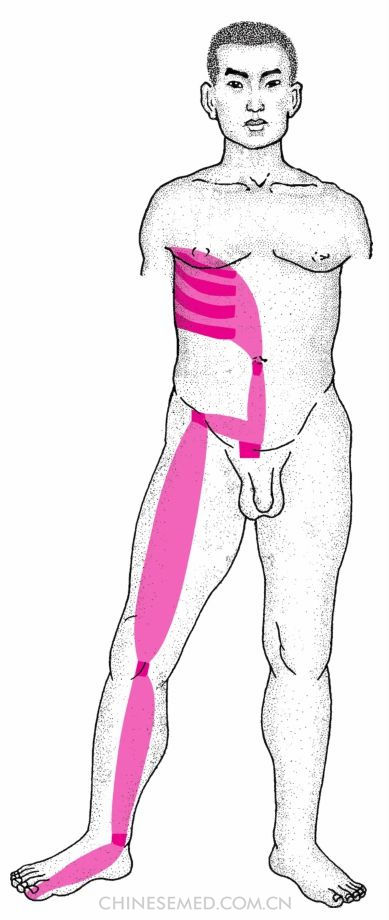

Channel course summary
- The foot taiyin spleen channel travels from the foot to the chest.
- It intersects with the foot jueyin liver channel eight cun above the medial malleolus.
- It pertains to the spleen and connects with the stomach, enters the heart, associates with the root of the tongue, and disperses over the lower surface of the tongue. The channel divergence surrounds the root of the tongue. The channel sinew binds at the genitals.
- It connects with the foot yangming stomach channel at the medial side of the big toe and with the hand shaoyin heart channel in the heart.
- It has two divergent collaterals. One separates at SP 4 (gōng sūn); the other, at SP 21 (dà bāo).
2. Disorders of the Foot Taiyin System
(1) Channel disorders
Channel qi disorders produce rigidity at the root of the tongue, vomiting after eating, epigastric pain, abdominal distention, belching, loose stool, diarrhea, edema, and jaundice. The patient feels better after defecation or flatus, but a sense of heaviness in the body remains.
The spleen channel is used to treat pain at the root of the tongue, difficulty in turning and moving, inability to ingest food, frustration, epigastric pain, loose stool or dysentery, water retention, inability to urinate or defecate, jaundice, restlessness, coldness at the medial aspect of thigh and knee, and immobility of the big toe. Standing is difficult and produces swelling.
(2) Divergent collateral disorders
A. In divergent collateral disorders, the ascending counterflow of qi can produce choleralike symptoms. The excess pattern presents as acute abdominal pain; the deficiency pattern, as tympanites. To treat, use the luo-connecting point, SP 4 (gōng sūn).
B. In major divergent collateral disorders, the excess pattern presents as whole-body pain; the deficiency pattern, as weakness and flaccidity in bones and joints. The major collateral contains the blood of all the divergent collateral. To treat its disorders, use the major luo-connecting point of the spleen, SP 21 (dà bāo).
(3) Channel sinew disorders
Disorders in the foot taiyin channel sinew manifest as pain and cramping in the big toe that extends to the medial malleolus, the medial aspect of the knee, medial aspect of the thigh, and the inguinal region, as well as twisting pain in the genitals. These may be accompanied by umbilical and hypochondrial pain, which can lead to pain in the chest and the paraspinal muscles.
Summary of spleen system disorders
- Disorders of the spleen and stomach: Vomiting after eating, stomachache, abdominal distention, belching, loose stool, diarrhea, edema, jaundice.
- Disorders of the tongue: Pain at the root, rigidity, flaccidity.
- Disorders of the heart: Frustration, insomnia.
- Disorders of the exterior course: Swelling in knee and thigh, reversal cold, painful limbs.
- Gynecological disorders: Dysmenorrhea, menstrual irregularities, flooding and spotting, abnormal vaginal discharge, vomiting and nausea during pregnancy, difficult labor, retention of the placenta, persistent lochia, infertility.
- Disorders of the genitourinary system: Enuresis, frequent urination, retention of urine, strangury, seminal emission, impotence, infertility.
- Dermatological disorders: Pruritus of the skin, eczema, rash.
The Hand Shaoyin System
1. Running Course of the Hand Shaoyin System
(1) Channel
The hand shaoyin heart channel originates in the heart, emerges from the system of blood vessels pertaining to the heart, and descends through the diaphragm to connect with the small intestine. A branch of the channel leaves the heart, ascends along the esophagus, and connects with the eye. The direct branch ascends toward the lungs, emerges at the axilla, and follows the medial aspect of the upper arm posterior to the hand jueyin pericardium channel. It enters the elbow and travels on the posteromedial aspect of the forearm to the pisiform. It enters the palm, travels along the radial side of the little finger, and terminates at its tip, where it connects with the hand taiyang small intestine channel (Pic. 1-21).
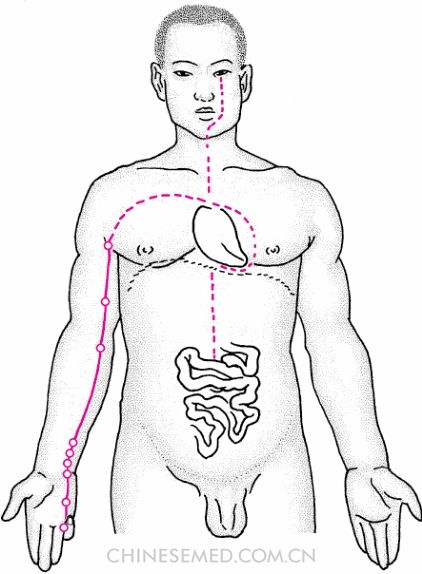
(2) Divergent collateral
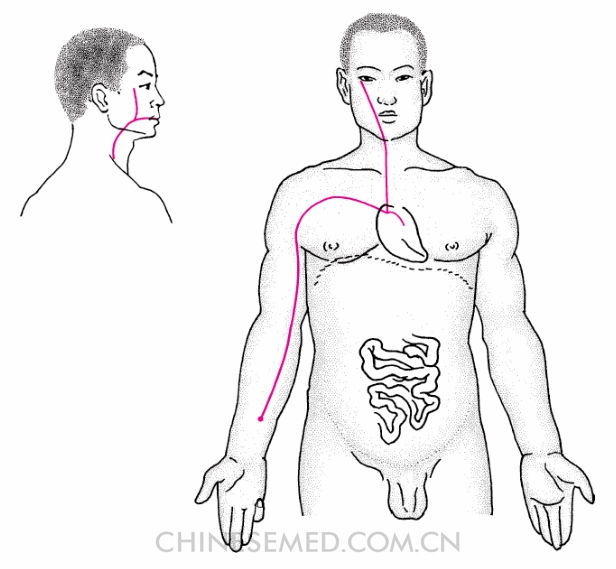
The hand shaoyin divergent collateral separates at HT 5 (tōng lĭ) one cun above the wrist and ascends alongside the primary channel to enter the heart. It continues upward to connect with the root of the tongue and the eye. The divergent collateral also connects to the hand taiyang small intestine channel (Pic. 1-22).
(3) Channel divergence
The hand shaoyin channel divergence separates from the primary channel and enters into the depth of the axilla between two tendons. It connects with its pertaining zang organ, the heart, and ascends to the throat to exit at the facial region. It meets the hand taiyang channel divergence at the medial canthus. This is the fourth confluence (Pic. 1-23).
(4) Channel sinew
The hand shaoyin channel sinew begins at the radial aspect of the little finger. It ascends along the finger, binds at the pisiform, and ascends to bind at the medial aspect of the elbow. It travels into the axilla, crosses the hand taiyin channel sinew in the breast region, and binds in the center of the chest. It descends through the diaphragm to connect with the umbilicus (Pic. 1-24).
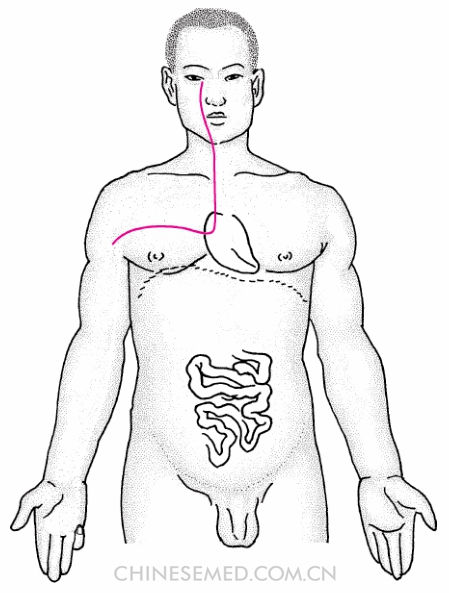

Channel course summary
- The hand shaoyin channel travels from the chest to the hand.
- It runs along the medial aspect of the upper arm at the posterior border.
- It pertains to the heart and connects with the small intestine. It also connects with the lung and associates with the eye. The divergent collateral connects with the root of the tongue. Its channel divergence exits at the face. Its channel sinew connects with the umbilicus.
- It connects with the hand taiyang small intestine channel at the radial side of the little finger.
2. Disorders of the Hand Shaoyin System
(1) Channel disorders
Disorderly channel qi produces dry throat, pain in the heart, and thirst with desire to drink; these are accompanied by bì jué, which is blood and qi stagnation in the arm.
The heart channel is used to treat yellow sclera, distention and pain in the hypochondrium, pain and cold along the posterior border of the medial aspect of the upper arm and forearm, and heat and pain in the palm.
(2) Divergent collateral disorders
In disorders of the divergent collateral, the excess pattern presents as an uncomfortable, stuffy sensation between the chest and diaphragm. The deficiency pattern presents as inability to speak. Treat using the luo-connecting point, HT 5 (tōng lĭ), located one cun above the medial aspect of the wrist.
(3) Channel sinew disorders
Disorders in the hand shaoyin channel sinew present as tension in the chest and a hard mass at the epigastrium known as fú liáng (伏梁). Disorders in the channel sinew of the upper limb cause spasms and the inability to flex the elbow, as well as cramping and pain along the course and at the binding regions of the channel.
Summary of heart system disorders
- Disorders of the heart: Heart pain, palpitations.
- Disorders of the channel: Pain, reversal cold, and numbness along the posterior border of the medial aspect of the upper limb.
- Disorders of the tongue: Sudden loss of voice, rigid tongue, aphasia.
- Other heart system problems include insomnia, mania, depression, psychosis, and persistent laughter.
The Hand Taiyang System
1. Running Course of the Hand Taiyang System
(1) Channel
The hand taiyang small intestine channel originates at the ulnar side of the tip of the little finger, ascends the ulnar aspect of the dorsum of the hand to the wrist, and emerges at the styloid process. It ascends the inferior border of the ulna, passes between the olecranon and the medial epicondyle of the humerus, and continues along the posterolateral aspect of the upper arm to emerge at the posterior aspect of the shoulder. It travels in a zigzag manner along the superior border of the scapula, rises to meet DU 14 (dà zhuī), and descends into the supraclavicular fossa. It connects with the heart, passes along the esophagus and through the diaphragm to the stomach, and unites with its pertaining fu organ, the small intestine. A branch from the supraclavicular fossa ascends to the neck and cheek; at the lateral canthus, it enters the ear. The branch from the cheek ascends to the infraorbital region, goes to the lateral aspect of the nose, and joins the foot taiyang bladder channel at the medial canthus (Pic. 1-25).
(2) Divergent collateral
The hand taiyang divergent collateral separates at SI 7 (zhī zhèng) five cun above the posterolateral aspect of the wrist and moves internally to connect with the hand shaoyin heart channel. A branch ascends and crosses the elbow. At LI 15 (jiān yú), it connects to the shoulder joint (Pic. 1-26).
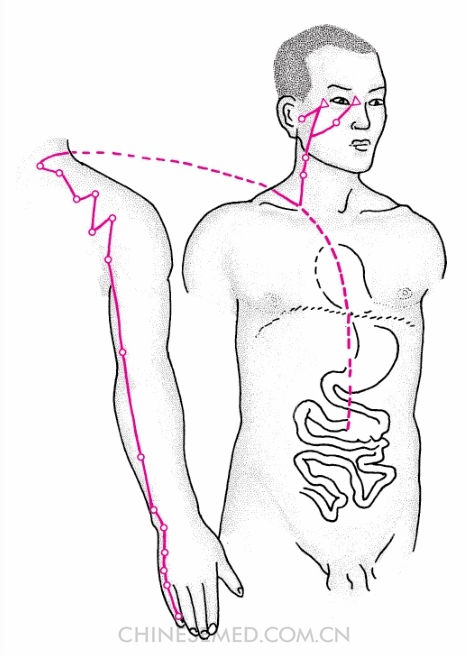

(3) Channel divergence
The hand taiyang channel divergence separates from the primary channel at the shoulder, enters the axilla, crosses the heart, and connects with its pertaining fu organ, the small intestine (Pic. 1-27).
(4) Channel sinew
The hand taiyang channel sinew begins at the dorsum of the little finger and binds at the wrist. It ascends the forearm and binds posterior to the medial epicondyle of the humerus; plucking the sinew at this area sends a sore and numb sensation to the little finger. The channel continues up the arm and binds at the axilla. A branch travels behind the axilla, circles the scapula, moves up the neck, and exits anterior to the foot taiyang channel sinew to bind behind the ear at the mastoid process. A branch separates and enters the ear. The main branch exits above the ear, descends to bind at the mandible, and rises to meet the lateral canthus (Pic. 1-28).

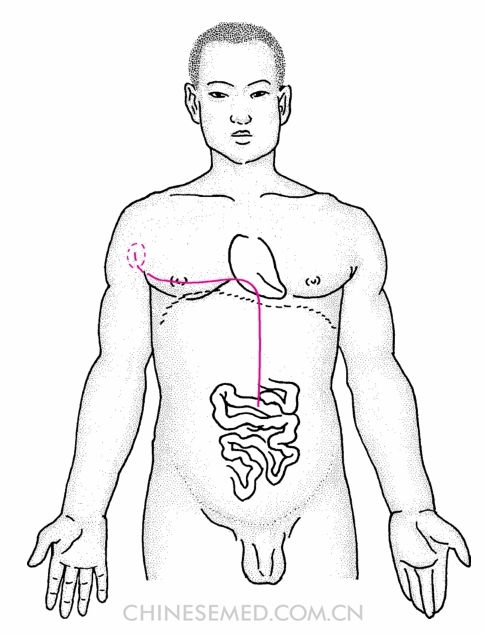
Channel course summary
- The hand taiyang channel travels from the hand to the head along the posterolateral aspect of the upper limb.
- Because it associates closely with the shoulder and scapula, it is known as the ‘shoulder channel’ .
- It has a complex distribution on the cheek that includes the medial and lateral canthus and the side of the nose, where it enters the ear.
- It pertains to the small intestine, connects with the heart, travels along the esophagus, and reaches the stomach. It intersects with the foot taiyang bladder channel at the medial canthus.


2. Disorders of the Hand Taiyang System
(1) Channel disorders
Disorderly channel qi produces throat pain, swelling at the mandible, difficulty in turning the head, wrenching shoulder pain, and pain in the upper limb.
The channel is used to treat fluid disorders that include deafiness, yellow sclera, and swelling of the cheek, as well as pain at the posterolateral aspect of the neck, mandible, shoulder, upper arm, elbow, and forearm.
(2) Divergent collateral disorders
In divergent collateral disorders, the excess pattern presents as flaccidity of the joints and atrophy and immobility of the elbow joint. The deficiency pattern presents as fleshy excrescences. To treat, use the luo-connecting point, SI 7 (zhī zhèng).
(3) Channel sinew disorders
Disorders in the hand taiyang channel sinew cause pain at the little finger that extends to the posterior border of the medial epicondyle of the humerus, along the medial aspect of the upper arm, and behind the axilla; neck pain accompanied by tinnitus and earache; and pain that involves the mandible and forces one to close the eyes in order to see again. Spasms in the channel sinew can produce flaccidity and swelling of the neck.
Summary of small intestine system disorders
- Channel disorders: Inflammation and paralysis, especially of the shoulder.
- Disorders of the neck and back: Stiff neck, cervical spondylosis.
- Disorders of the ear: Deafiness, tinnitus, otitis media.
- Disorders of the face and cheek: Paralysis, pain.
- Disorders of the lower back: Acute and chronic low back pain.
The Foot Taiyang System
1. Running Course of the Foot Taiyang System
(1) Channel
The foot taiyang bladder channel originates at BL 1 (jīng míng) at the medial canthus. It ascends to the forehead and joins the dumai at the vertex. A branch descends to the temple. The main portion enters the brain and emerges to descend along the nape of the neck, where it splits into two branches. The first branch descends along the medial border of the scapula alongside the vertebral column to the lumbar region. It enters the body via the paraspinal muscles to connect with its exterior-interiorly related organ, the kidney, and its pertaining fu organ, the bladder. A fork from the middle of the lumbar region descends along the same muscles and through the gluteal region to end in the popliteal fossa. The second branch traverses the scapula, descends parallel to the vertebral column, crosses the hip joint, continues along the lateral aspect of the thigh, and rejoins the first branch in the popliteal fossa. From there, it descends through the gastrocnemius and emerges posterior to the lateral malleolus. It follows the fifth metatarsal to the lateral side of the tip of the little toe, where it intersects with the foot shaoyin kidney channel (Pic. 1-29).

(2) Divergent collateral
The foot taiyang divergent collateral arises at BL 58 (fēi yáng) seven cun above the lateral malleolus and connects to the foot shaoyin kidney channel (Pic. 1-30).
(3) Channel divergence
The foot taiyang channel divergence derives from its primary channel in the popliteal fossa, travels upward to a point five cun below the sacrum, then winds around the anal region to connect with the bladder and disperse in the kidney. It follows the paraspinal muscles and disperses in the cardiac region; the direct branch ascends along the paraspinal muscles to the nape, where it rejoins its primary channel (Pic. 1-31).
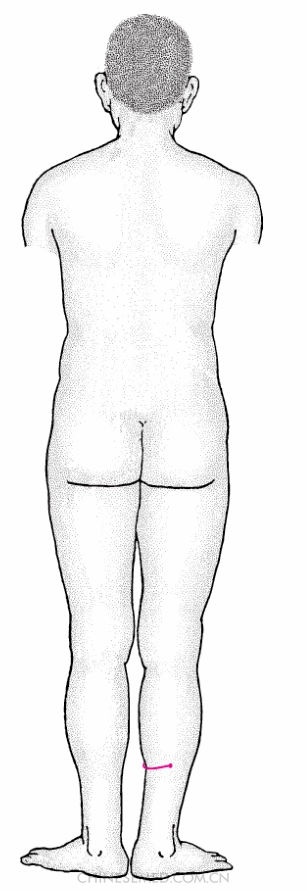

(4) Channel sinew
The foot taiyang channel sinew originates at the little toe. It rises to bind at the lateral malleolus and at the anterior knee. A branch separates below the malleolus, moves along the heel, and ascends to bind laterally at the popliteal fossa. Another branch separates at the convergence of the medial and lateral gastrocnemius and ascends to bind at the medial aspect of the popliteal fossa. These two branches join in the gluteal region and run beside the spine to the nape, where a branch enters the root of the tongue. The main branch binds at the occiput and crosses the vertex to bind at the bridge of the nose. A branch spreads around the eye and binds at the zygomatic region. Another branch extends from the lateral aspect of the posterior axillary fold to bind at the shoulder. Yet another enters the axilla, travels to the supraclavicular fossa, and ascends to bind at the mastoid process behind the ear. A further branch emerges from the supraclavicular fossa, ascends obliquely to the zygomatic arch, and meets with the previous branch that binds at the zygomatic region (Pic. 1-32).

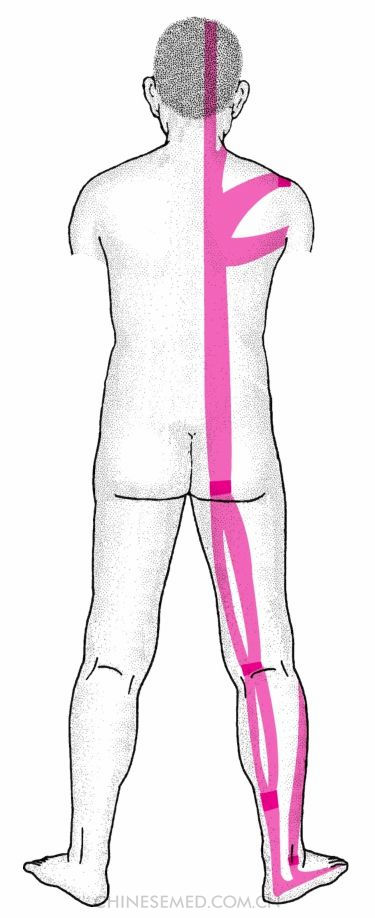
Channel course summary
- The channel has an extensive distribution, running from the head to the foot. Because it traverses the posterior aspect of the body and lower limbs, it acts as the ‘fence’ of the six yang channels and is called the ‘greater yang’.
- It pertains to the bladder and connects with the kidney and the brain. Its channel divergence disperses in the heart and enters the anus. Its channel sinew binds at the tongue and the nose.
- It runs in two parallel lines along the back, respectively 1.5 and 3 cun from the posterior midline. The channel qi of the zang-fu organs gathers at acupoints along the first lateral line of the back. These points are significant for diagnosis and treatment of diseases of the internal organs and their related tissues.
- It intersects with the foot shaoyin kidney channel at the lateral side of the little toe.
2. Disorders of the Foot Taiyang System
(1) Channel disorders
Disorderly channel qi ascends, resulting in headache, pressure as if the eye might become dislodged, neck strain, back pain, wrenching pain in the lower back, inability to flex or extend the thigh, restriction at the popliteal fossa as if the tendon were bound, and extreme calf pain known as huái jué (踝厥).
The channel is used to treat tendon-related disorders, hemorrhoids, malaria, mania, depression, head and neck pain, yellowing of the sclera, tearing and runny nose, nasal obstruction, nosebleed. Additionally, it treats neck, back, lumbar, sacral, coccyx, anterior knee, calf and foot pain, as well as immobility of the little toe.
(2) Divergent collateral disorders
In divergent collateral disorders, the excess pattern presents as nasal obstruction and head and back pain. The deficiency pattern presents as nasal congestion, runny nose, and nosebleed. To treat, use the luo-connecting point, BL 58 (fēi yáng).
(3) Channel sinew disorders
Disorders of the foot taiyang channel sinew present as pain and cramping of the little toe and heel, popliteal fossa spasms, arching of the back, neck sinew spasms, inability to raise the shoulder, pain and strain at the axilla and supraclavicular fossa, and inability to turn the body left and right.
Summary of bladder system disorders
- Disorders of the bladder channel: Headache; pain at the upper orbit; pain and rigidity of the neck, back and lumbar region; swelling and pain in the patella; gastrocnemius spasms; pain and swelling at the dorsum of the foot.
- Disorders of the zang-fu organs: Channel qi of the zang-fu organs gathers at acupoints on the back along the first lateral line of the foot taiyang bladder channel. These points are significant in diagnosis and treatment of diseases of the internal organs and their related tissues.
- Externally contracted diseases: Taiyang cold syndrome, wind invasion, malaria.
- Mental disorders: Depression, mania, epilepsy.
- Disorders of the eye, nose, and anus: Yellowing of the sclera, tearing, allergic rhinitis, nosebleed, nasal congestion, hemorrhoids, prolapsed rectum.
The Foot Shaoyin System
1. Running Course of the Foot Shaoyin System
(1) Channel
The foot shaoyin kidney channel originates beneath the little toe, crosses diagonally to the center of the sole of the foot, and emerges anterior to the navicular tuberosity at KI 2 (rángŭ). It travels posterior to the medial malleolus, enters the heel, ascends on the medial aspect of the lower leg, and emerges at the medial aspect of the popliteal fossa. From there it ascends posteromedially on the thigh and travels toward the vertebral column. It associates with its pertaining zang organ, the kidney, and connects with its exterior-interior related fu organ, the bladder. A direct branch from the kidney passes through the liver and diaphragm, enters the lung, and ascends along the throat to reach the root of the tongue. Another branch emerges from the lung to connect with the heart and enter the chest, where it joins the hand jueyin pericardium channel (Pic. 1-33).
(2) Divergent collateral
The foot shaoyin divergent collateral separates at KI 4 (dà zhōng) at the posterior aspect of the medial malleolus and circles the heel. One branch joins the foot taiyang bladder channel. Another branch ascends with the primary channel to below the pericardium, descends, and crosses the lumbar vertebrae (Pic. 1-34).
(3) Channel divergence

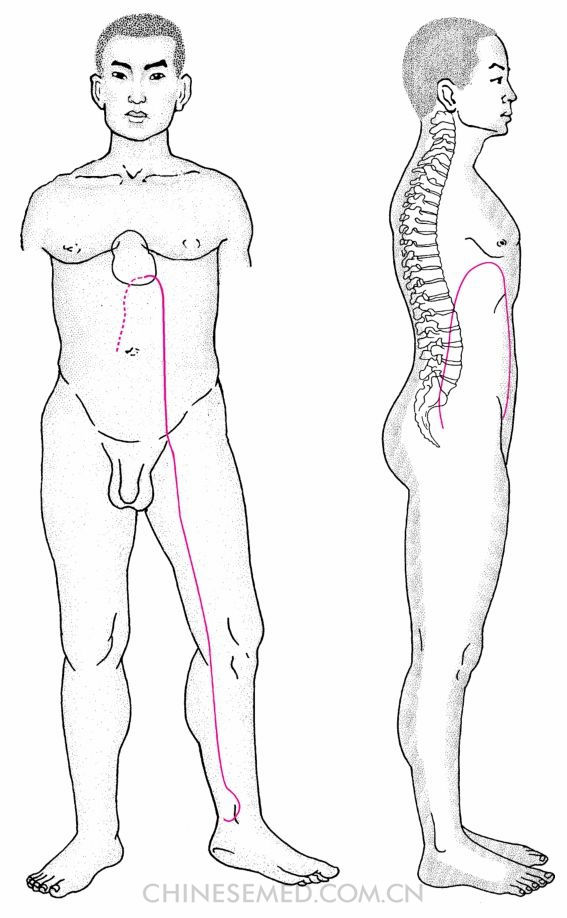
The foot shaoyin channel divergence separates from the primary channel at the popliteal fossa. A branch intersects the foot taiyang channel divergence and ascends to the kidney. It exits at the second lumbar vertebra and crosses the dai mai. The direct branch ascends to the root of the tongue and emerges at the nape of the neck to join the foot taiyang bladder channel (Pic. 1-35). This is the first exterior-interior confluence.
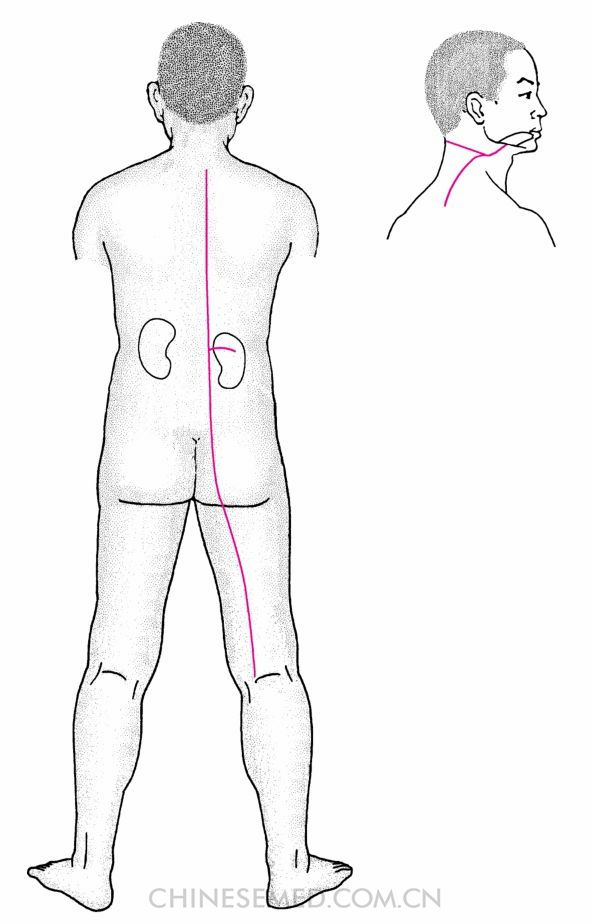
(4) Channel sinew
The foot shaoyin channel sinew begins beneath the little toe, enters the center of the sole of the foot, and travels medially to merge with the foot taiyin channel sinew. It ascends diagonally to the inferior aspect of the medial malleolus, and binds at the heel. It ascends, binds at the medial condyle of the tibia, and joins the foot taiyin channel sinew. It goes up the medial aspect of the thigh and binds at the genitals. It travels into the deep region of the spine, ascends beside the spine to the nape of the neck, binds at the occiput, and converges with the foot taiyang channel sinew (Pic. 1-36).

Channel course summary
- Traveling at the posteromedial aspect of the lower limbs, the foot shaoyin channel goes from the foot to the root of the tongue.
- It has relationships with several zang-fu organs. It pertains to the kidney, connects with the bladder, passes through the liver, enters the lung, and connects with the heart.
- It runs along the throat and connects with the root of the tongue. The divergent collateral crosses the lower back externally. The channel sinew binds at the genitals.
- It intersects with the hand jueyin pericardium channel in the chest.
2. Disorders of the Foot Shaoyin System
(1) Channel disorders
Channel qi disorders include lack of desire to eat despite hunger; an emaciated, darkcomplected, lusterless face; spitting of phlegm mixed with blood; wheezing; inability to lie flat; an immediate desire to get up after sitting; blurred vision; and an uneasy feeling akin to hunger pangs, as if the heart were suspended in midair. Kidney qi deficiency can produce extreme fear and severe palpitations, as if one is being chased; this condition is due to the disorder of bones (gǔjué, 骨厥).
The channel is used to treat disorders including a feverish sensation in the mouth, dry tongue, swelling of the throat, ascending counterflow of qi, a dry and painful throat, restlessness with discomfort in the cardiac region, flaccid and cold feet, sleepiness, and heat and pain in the sole of the foot.
(2) Divergent collateral disorders
Qi counterflow in the divergent collateral produces restlessness. The excess pattern presents as ischuria; deficiency presents as low back pain. To treat, use the luo-connecting point KI 4 (dà zhōng).
(3) Channel sinew disorders
Disorders in the foot shaoyin channel sinew present as cramping of the foot, pain and cramping along its running course and binding areas, epilepsy, and spasms with arching and rigidity in the back and nape. If the back is affected, the patient cannot bend forward. If the thorax or abdomen is affected, the patient cannot bend backward. The back belongs to yang; the abdomen, to yin. In yang diseases, the channel sinews of the back and the nape are rigid, the lower back takes on a reversed curvature, and the body is unable to bend forward. In yin diseases, the channel sinews of the abdomen are rigid and prevent the body from bending backward.
Summary of kidney system disorders
- Disorders of the zang organs: Kidney yin, yang, or qi deficiency; disharmony of heart and kidney; liver-kidney yin deficiency; spleen-kidney yang deficiency; lung-kidney qi deficiency.
- Disorders of the tongue and throat: Pain at the root of the tongue, ulcers on the root of the tongue, swelling of the throat.
- Disorders of the bladder: Ischuria.
- Disorders of the kidney channel: Pain and cold at the posteromedial aspect of the lower limbs, back and lumbar pain.
The Hand Jueyin System
1. Running Course of the Hand Jueyin System
(1) Channel
The hand jueyin pericardium channel originates in the center of the chest. It connects with the pericardium and descends through the diaphragm and the abdomen, connecting with the upper, middle, and lower jiao. The main branch runs from the chest, emerges in the costal region three cun inferior to the axilla fold, and ascends to the axilla. It then travels along the medial aspect of the upper arm between the hand taiyin lung and hand shaoyin heart channels to the cubital fossa, and descends along the forearm between the tendons of the palmaris longus and flexor carpi radialis muscles to reach the palm. It runs along the middle finger and terminates at its tip. Another branch separates inside the palm; it follows the ring finger to its tip to connect with the hand shaoyangsanjiao channel (Pic. 1-37).
(2) Divergent collateral
The hand jueyin divergent collateral separates from the primary channel two cun above the wrist at PC 6 (nèi guān) and exits between the two tendons to connect to the hand shaoyang sanjiao channel. It ascends along the primary channel to associate with the pericardium and connect with the heart system (Pic. 1-38).
(3) Channel divergence
The hand jueyin channel divergence separates three cun below the axilla, enters the chest, and connects with its exterior-interior related fu organ, the sanjiao. It ascends and exits along the throat, emerges behind the ear, and joins the hand shaoyang sanjiao channel below the mastoid process (Pic. 1-39). This is the fifth exterior-interior confluence.
(4) Channel sinew
The hand jueyin channel sinew begins at the tip of the middle finger. It joins the hand taiyin channel sinew and travels upward, binding first at the medial aspect of the elbow, then below the axilla. It descends to disperse at the anterior and posterior aspects of the ribs and at the hypochondrium. A branch enters below the axilla, disperses in the chest, and binds at the diaphragm (Pic. 1-40).
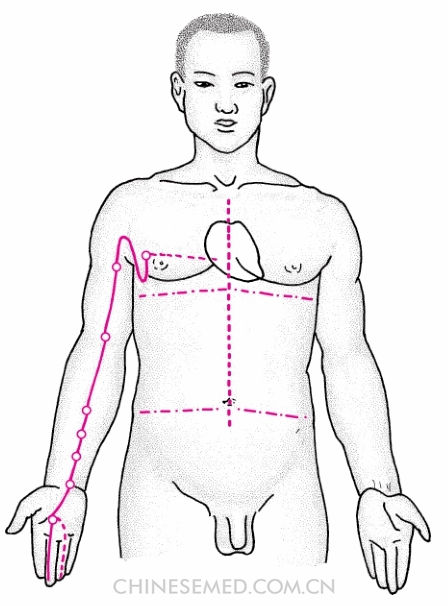
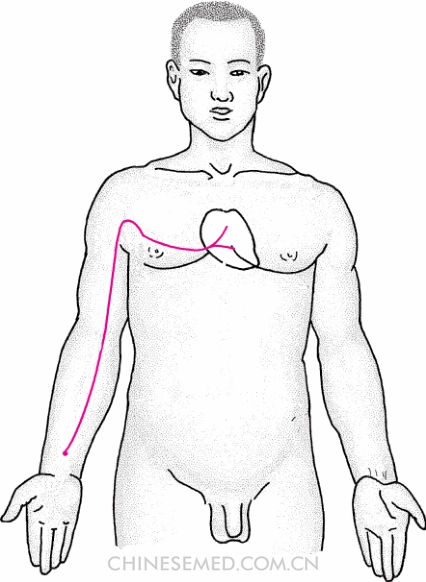

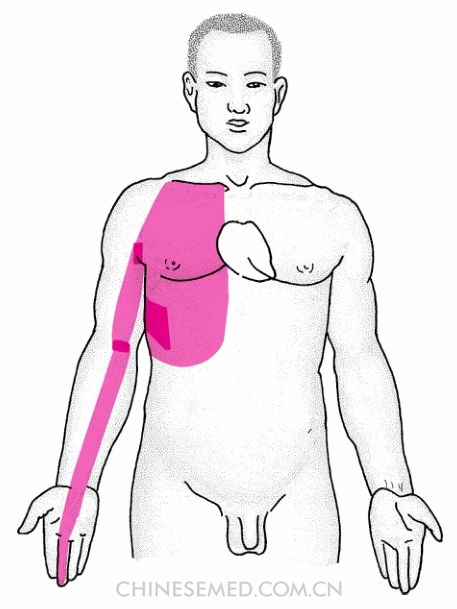
Channel course summary
- The hand jueyin channel travels from the chest to the hand at the center of the medial aspect of the upper limb.
- It pertains to the pericardium and connects with the sanjiao. The divergent collateral connects with the heart. The channel divergence travels along the throat. The channel sinew binds at the diaphragm.
- It intersects with the hand shaoyang sanjiao channel at the ulnar side of the ring finger.
2. Disorders of the Hand Jueyin System
(1) Channel disorders
Disorderly channel qi produces heat in the palm, spasms in the upper limb and elbow, swelling below the axilla, a sense of fullness and tightness in the chest, a pounding heart and fearfulness, reddened face, yellow sclera, and persistent and inappropriate laughter.
The channel is used to treat vessel disorders, including frustration, heart pain, and heat in the palm.
(2) Divergent collateral disorders
Excess disorders in the divergent collateral present as heart pain; deficiency disorders, as irritability. To treat, use PC 6 (nèi guān) two cun above the wrist between the two tendons.
(3) Channel sinew disorders
Disorders in the hand jueyin channel sinew cause chest pain, cramping, and spasms along the course of the channel and where it binds and can result in a severe condition caused by lung qi stagnation known as xī bēn disease.
Summary of pericardium system disorders
- Disorders of the heart, both mental and physical: Heart pain, irritation, persistent and inappropriate laughter, pounding heart, mania, depression; in infants, night crying.
- Disorders of the chest: Coughing and shortness of breath, chest pain, distending pain in the breasts.
- Disorders of the channel: Spasms in upper limb and elbow, swelling of the axilla, fullness in chest and hypochondrium.
- Disorders of the middle and lower jiao: Vomiting, hiccups, distending pain in the stomach, diarrhea, abdominal pain.
The Hand Shaoyang System
1. Running Course of the Hand Shaoyang System
(1) Channel
The hand shaoyang sanjiao channel originates at the tip of the ring finger and ascends to the wrist on the dorsum of the hand between the fourth and fifth metacarpal bones. It emerges between the radius and ulna at the lateral aspect of the forearm, traverses the elbow, and ascends the lateral aspect of the upper arm to the shoulder. It intersects the foot shaoyang gallbladder channel, enters the supraclavicular fossa, and travels to RN 17 (dàn zhōng). It connects with the pericardium and descends through the diaphragm and the abdomen to link with the upper, middle, and lower jiao. One branch separates at RN 17 (dàn zhōng), ascends to emerge from the supraclavicular fossa, runs along the neck to the posterior aspect of the ear, and proceeds to the superior aspect of the ear. From there, it winds downward across the cheek to the inferior aspect of the orbit. Another branch separates behind the auricle and enters the ear. It emerges in front of the ear, crosses anterior to GB 3 (shàngguān), intersects with the previous branch at the cheek, and ascends to the lateral canthus to connect with the foot shaoyang gallbladder channel (Pic. 1-41).
(2) Divergent collateral
The hand shaoyang divergent collateral separates at SJ 5 (wài guān) two cun above the wrist, travels on the lateral aspect of the arm, and ascends to enter the chest, where it converges with the hand jueyin pericardium channel (Pic. 1-42).
(3) Channel divergence
The hand shaoyang channel divergence separates from the primary channel at the vertex on the head. It enters the supraclavicular fossa, descends to its pertaining fu organ, the sanjiao, and disperses in the chest (Pic. 1-43).
(4) Channel sinew
The hand shaoyang channel sinew begins at the ulnar side of the ring finger and binds at the wrist. It ascends along the arm and binds at the elbow, travels the lateral aspect of the upper arm, and crosses the shoulder to the neck to join the hand taiyang channel sinew. A branch separates at the neck and enters internally at the mandible to associate with the root of the tongue. Another branch ascends to the maxillary teeth, travels anterior to the ear, and connects to the lateral canthus. It then ascends to the temple to bind at the corner of the forehead (Pic. 1-44).
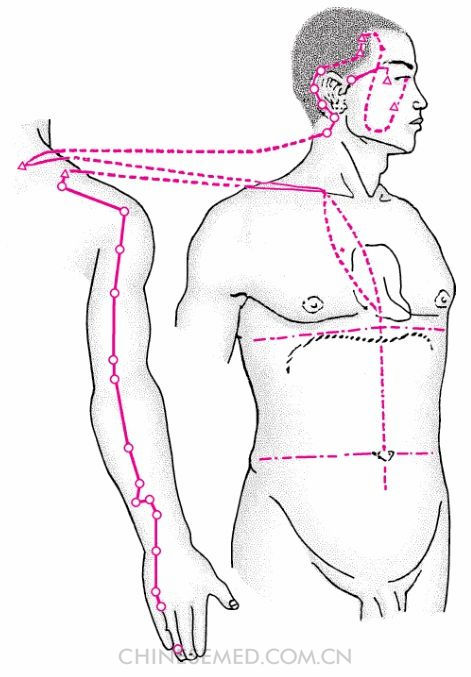

Channel course summary
- The sanjiao channel travels from the hand to the head at the center of the lateral aspect of the arm.
- It has a close association with the ear and is known as the ‘ear channel’. It distributes to the anterior, posterior and superior aspects of the ear, and enters the ear.
- It pertains to the sanjiao and connects with the pericardium. Its channel sinew enters at the mandible to associate with the root of the tongue.
- It intersects with the foot shaoyang gallbladder channel at the lateral canthus.
2. Disorders of the Hand Shaoyang System
(1) Channel disorders
Disorderly channel qi can produce deafiness with ringing in the ears, pain and swelling of the throat, and pharyngitis.
The channel is used to treat qi disorders, including spontaneous sweating, pain at the lateral canthus and behind the ear, swelling of the cheek, immobility of the ring finger, and pain at the lateral aspects of shoulder, upper arm, elbow, and forearm.
(2) Divergent collateral disorders
In divergent collateral disorders, the excess pattern presents as elbow spasms; the deficiency, as elbow flaccidity. To treat, use the luo-connecting point, SJ 5 (wài guān).


(3) Channel sinew disorders
Hand shaoyang channel sinew disorders include curling of the tongue and strain and cramping along the channel course and at the binding regions.
Summary of sanjiao system disorders
- Disorders of the ear: Deafiness, tinnitus, ear pain and itching, otopyorrhea.
- Disorders of the sanjiao channel: Shoulder, upper arm, elbow, and forearm pain; paralysis of the fourth and little fingers.
- Sweating symptoms: Spontaneous or absence of sweating.
- Disorders of the sanjiao fu organ: Chest and hypochondrial pain, constipation, infantile enuresis.
The Foot Shaoyang System
1. Running Course of the Foot Shaoyang System
(1) Channel
The foot shaoyang gallbladder channel originates at the lateral canthus, ascends to the corner of the forehead, descends to curve behind the ear, and runs down the neck anterior to the hand shaoyang sanjiao channel. It reaches the shoulder, crosses posterior to the hand shaoyang sanjiao channel, and enters the supraclavicular fossa. One branch emerges posterior to the auricle, enters the ear, emerges anterior to it, and travels to the posterior aspect of the lateral canthus. Another branch starts from the lateral canthus, descends to ST 5 (dà yíng), meets with the hand shaoyang sanjiao channel, and ascends to the infraorbital region. It then moves down, passes ST 6 (jiá chē) and descends along the neck to join the first branch at the supraclavicular fossa. From there it descends into the chest, crosses the diaphragm to associate with the liver, and connects with its pertaining fu organ, the gallbladder. It travels inside the hypochondrium to reach the inguinal region, curves around the pubic hair, and travels horizontally into the hip at GB 30 (huán tiào). The direct branch descends from the supraclavicular fossa to the axilla to traverse the chest and the floating ribs. It descends to meet the previous branch at GB 30 (huán tiào), continues down the lateral aspect of thigh and knee, and descends anterior to the fibula to GB 39 (xuán zhōng), a depression three cun above the lateral malleolus. It exits anterior to the lateral malleolus and follows the dorsum of the foot between the fourth and fifth metatarsals to the lateral aspect of the tip of the fourth toe. Another branch separates from the primary channel at the dorsum and runs between the first and second metatarsals to the tip of the big toe. It goes through the toenail to terminate at the hairy region of the big toe and connect to the foot jueyin liver channel (Pic. 1-45).
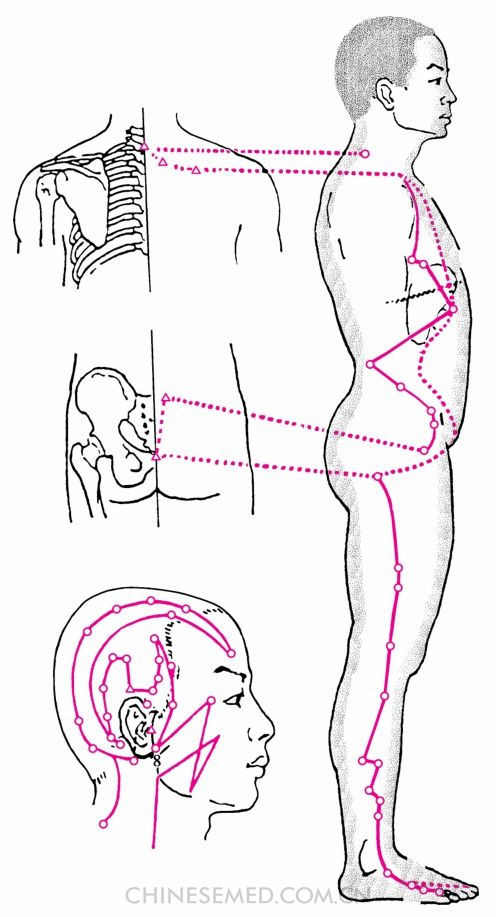
(2) Divergent collateral
The foot shaoyang divergent collateral separates at GB 37 (guāng míng) five cun above the lateral malleolus. It branches into the foot jueyin liver channel and descends to disperse over the dorsum of the foot (Pic. 1-46).
(3) Channel divergence
The foot shaoyang channel divergence separates from the primary channel at the thigh, enters the lower abdomen in the pelvic region, and converges with the foot jueyin liver channel. A branch enters the region of the floating ribs; it associates with its pertaining fu organ, the gallbladder, and disperses in the liver. It ascends to enter the heart, continues along the side of the throat and emerges at the cheek to disperse in the face. It connects with the eye and rejoins its primary channel at the lateral canthus (Pic. 1-47).


(4) Channel sinew
The foot shaoyang channel sinew begins at the tip of the fourth toe, binds at the lateral malleolus, and ascends the lateral aspect of the tibia to bind at the knee. A branch originates at the fibula and ascends the thigh. Its anterior subbranch binds at the region superior to ST 32 (fú tù); its posterior subbranch binds at the sacrum. The main branch crosses the ribs anterior to the axilla, links with the breast, then binds at the supraclavicular fossa. Another branch ascends from the axilla and crosses the supraclavicular fossa; it travels anterior to the foot taiyang channel sinew and posterior to the ear to reach the temple. It ascends to the vertex, descends to the chin, and rises again to bind at the zygomatic region. A branch known as the lateral connecting sinew of the eye separates to bind at the lateral canthus (Pic. 1-48).
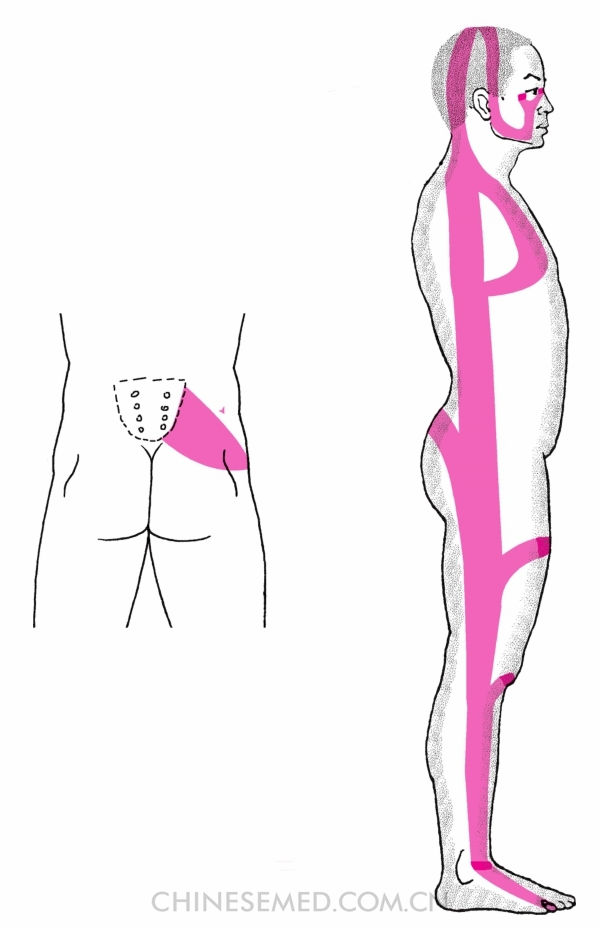
Channel course summary
- The foot shaoyang channel runs laterally on the body from head to foot.
- It has a complex distribution at the head. Its channel divergence disperses at the face.
- It has a close association with the ear, distributing to its posterior, interior, and anterior aspects.
- It pertains to the gallbladder and connects with the liver. Its channel divergence enters the heart, travels along the throat, and connects with the eye. Its channel sinew connects to the chest; the left and right channels connect at the vertex.
- It intersects with the foot jueyin liver channel at the big toe.
2. Disorders of the Foot Shaoyang System
(1) Channel disorders
Channel qi disorders include bitter taste, frequent sighing, chest and hypochondrial pain, and inability to turn the body. In more serious cases, there is dark and dull complexion, dry skin, and heat at the lateral aspect of the foot; this disease is known as yáng jué (阳厥).
The channel is used to treat bone disorders such as temple, inframandibular, and lateral canthus pain; swelling and pain at the supraclavicular fossa; swelling below the axilla; scrofula beside the neck or below the axilla; spontaneous sweating; chilliness; and malaria. It also treats pain at the lateral aspects of chest, hypochondrium, ribs, and thigh; knee pain that extends to the tibia, the inferior aspect of the fibula, and anterior to the lateral malleolus; immobility of the fourth toe; and pain in the respective joints.
(2) Divergent collateral disorders
In disorders of the divergent collateral, the excess pattern presents as coldness that travels from the lower to the upper part of the foot; the deficiency, as atony, weakness of the lower limb, limping, and falling with inability to get up. To treat, use the luo-connecting point, GB 37 (guāng míng).
(3) Channel sinew disorders
Disorders in the foot shaoyang channel sinew include strain and cramping at the fourth toe; cramping at the lateral aspect of the knee; inability to bend or stretch the knee; and spasms in the sinews at the popliteal fossa that extend to the upper thigh at the front and to the sacrum at the back, as well as spasms that radiate to the lateral costal region, supraclavicular fossa and neck. Spasms in the left sinew, which ascends to cross the right temple and travel with the qiaomai, affect the right side and vice versa. Because the yinqiao mai and yangqiao mai intersect at this area and the right and left sinews cross, when the left sinew is injured, the right eye cannot open, or, for example, the right foot is immobilized. This is known as the intersection of connecting sinews.
Summary of gallbladder system disorders
- Disorders of the gallbladder channel: Headache; pain at the chin and lateral canthus; swelling and pain in the supraclavicular fossa; neck spasms; stiff neck; swelling of the axilla accompanied by goiter; pain at the chest, hypochondrium, ribs, and thigh; knee pain that extends to the tibia; pain at the inferior aspect of the fibula; pain anterior to the lateral malleolus; pain in the respective joints; immobility of the fourth toe.
- Shaoyang syndrome: Bitter taste, dry throat, blurred vision, alternating chills and fever, fullness and discomfort in the chest and ribs, reluctance to speak or eat, irritation, frequent vomiting.
- Disorders of the gallbladder: Cholecystitis, gallstones, ascariasis in the bile duct.
- Disorders of the heart: Coronary heart disease, gallbladder and heart syndrome, neurosis, depression, mania.
- Disorders at the facial region: Dull complexion, paralysis, pain, muscle spasms, acne, yellowbrown macules.
- Disorders of the eye: Pain at the lateral canthus, myopia, glaucoma, central retinitis, optic atrophy.
- Disorders of the ear: Deafiness, tinnitus, otitis media.
- Disorders of the throat: Dry throat, abnormal sensations.
- Disorders of the stomach: Frequent and rapid vomiting, reluctance to eat.
- Disorders of the mammary gland: Acute mastitis, breast lumps.
The Foot Jueyin System
1. Running Course of the Foot Jueyin System
(1) Channel
The foot jueyin liver channel originates at the hairy region on the dorsum of the big toe, ascends to a point one cun anterior to the medial malleolus, and continues upward. Eight cun above the medial malleolus, it crosses behind the foot taiyin spleen channel and continues to run posterior to that channel. It rises to the medial aspect of the popliteal fossa and along the medial aspect of the thigh to enter the pubic region, where its left and right channels cross. It circles the genitals, ascends toward the lower abdomen, curves around the stomach, connects with its pertaining zang organ, the liver, and associates with the gallbladder. It ascends through the diaphragm and spreads in the hypochondrium. It continues along the posterior aspect of the throat to the face and nasopharynx. It connects with the eye, crosses the forehead, and meets the du mai at the vertex, DU 20 (băi huì). A branch descends from the eye to the inner cheek and circles the inside of the lips. Another branch separates from the liver, crosses the diaphragm, and enters the lung, where it connects with the hand taiyin lung channel (Pic. 1-49).
(2) Divergent collateral
The foot jueyin divergent collateral separates from the primary channel at LV 5 (lí gōu) five cun above the medial malleolus and branches into the foot shaoyang gallbladder channel. A branch travels along the path of the main channel, reaches the testicles, and gathers at the penis (Pic. 1-50).
(3) Channel divergence
The foot jueyin channel divergence ascends from the dorsum of the foot to the region of the pubic hair, where it converges and ascends with the foot shaoyang channel divergence (Pic. 1-51). This is the second exterior-interior confluence.
(4) Channel sinew
The foot jueyin channel sinew begins on the dorsum of the big toe, ascends, and binds anterior to the medial malleolus. It moves up the tibia and binds below the medial condyle of the tibia. It continues to ascend along the medial aspect of the thigh and binds at the external genitalia. It connects with the three yin foot channel sinews and the foot yangming channel sinew (Pic. 1-52).
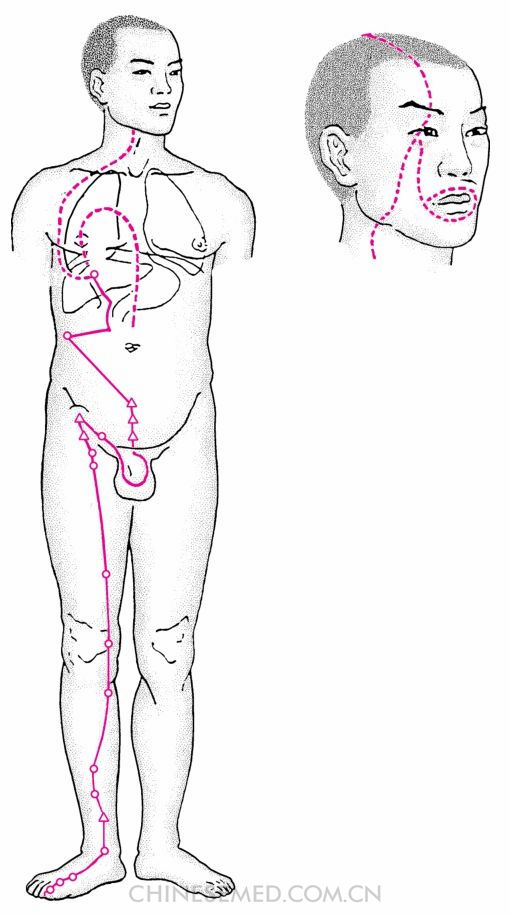
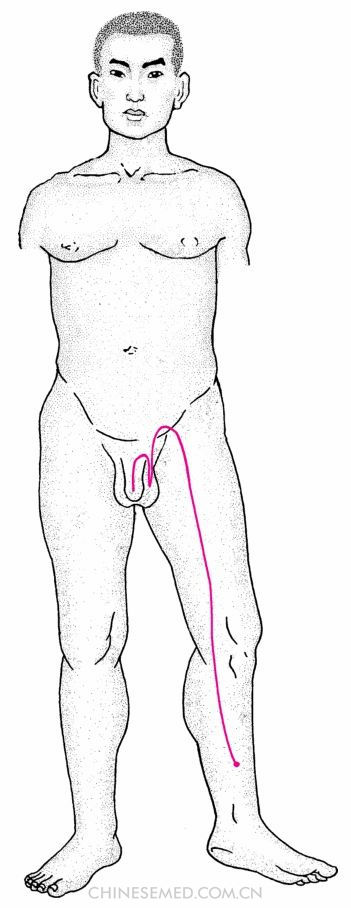
Channel course summary
- The foot jueyin channel travels from the foot to the head.
- It travels up the dorsum of the foot, which belongs to yang. It moves anterior to the foot taiyin spleen channel till a point eight cun above the medial malleolus. It meets with the du mai at the vertex, DU 20 (băi huì).
- It pertains to the liver and connects with the gallbladder. It crosses the stomach, enters the lung, associates with the eye, travels inside the cheek, and circles the inside of the lips.
- It has a close association with the external genitalia, which it circles. Its divergent collateral travels alongside the main channel to the testicles and binds at the penis. Its channel divergence ascends to the region of the pubic hair. Its channel sinew binds at the genitals.
- It intersects with the hand taiyin lung channel in the lung.

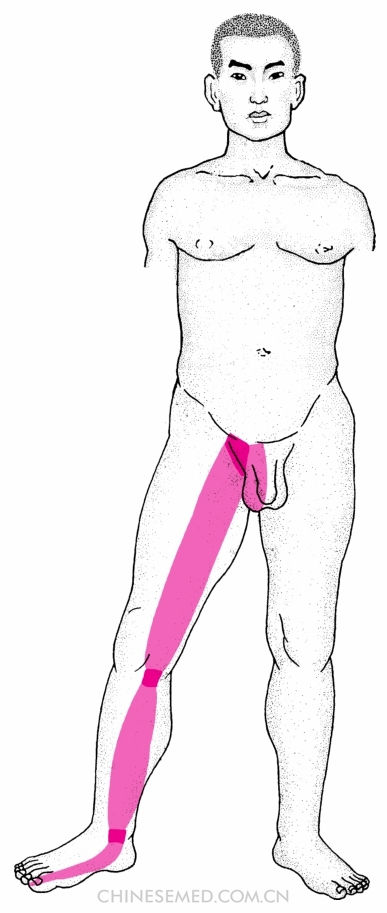
2. Disorders of the Foot Jueyin System
(1) Channel disorders
Channel qi disorders result in low back pain, inability to bend forward or backward, hernia in men, and swelling and distention of the lower abdomen in women. More serious conditions can produce dry throat with a dark and dull complexion.
The channel is used to treat liver disorders, including fullness and tightness in the chest, vomiting, qi counterflow, diarrhea with undigested food in the stool, inguinal hernia, and enuresis or urinary retention.
(2) Divergent collateral disorders
Ascending counterflow of qi in the divergent collateral produces the sudden onset of hernia and pain and swelling of the testicles. The excess pattern presents as prolonged erection of the penis; the deficiency pattern, as acute itching in the genital region. To treat, use the luo-connecting point of the liver channel, LV 5 (lí gōu).
(3) Channel sinew disorders
Foot jueyin channel sinew disorders include pain at the big toe that spreads to the anterior aspect of the medial malleolus, pain at the medial condyle of the tibia, pain and spasms at the medial aspect of the thigh, and dysfunction of the external genitalia. Overindulgence in sex can injure the yin essence, resulting in impotence and erectile dysfunction. If the injury is caused by cold, the genitals retract. If the injury is caused by heat, there is persistent erection.
Summary of liver system disorders
- Disorders of the internal organs: Besides liver disorders, the most commonly seen conditions are stomach and spleen disorders. ‘The liver is the thief of the zang organs’; thus complicated clinical symptoms usually include some liver dysfunction. Internal injury is the common etiology of internal organ disorders, and most disorders due to internal injuries are related to the liver.
- Disorders of the external genitalia: Impotence, persistent erection, prolapsed uterus, vaginal itching, swelling and pain at the genitals, eczema, urinary retention, and enuresis. These conditions are usually of an excess nature, hence the saying, ‘excess belongs to jueyin; deficiency, to shaoyin’. This is in contrast to ear disorders, where ‘excess belongs to shaoyang; deficiency, to shaoyin’.
- Disorders of the throat: Dry throat, abnormal throat sensations.
- Disorders of the eye: Glaucoma, myopia, disorders of the retina.
- Disorders of the face and mouth: Facial paralysis, pain, muscle spasms, recurrent mouth ulcers.
- Complex cold and heat symptoms: Heat in the upper region, cold in the lower.
- Pain in the vertex, characteristically, distending pain.

